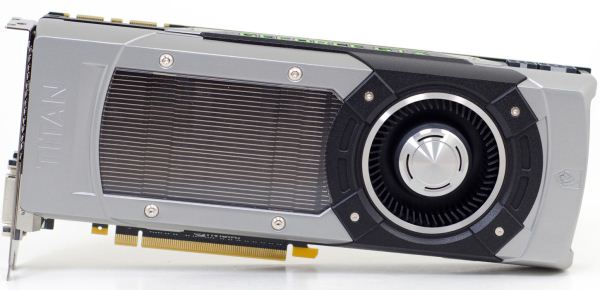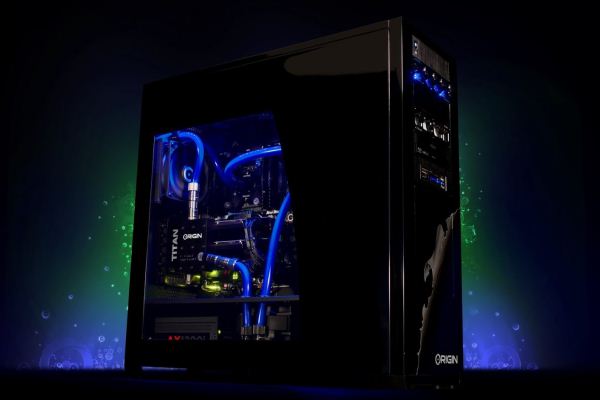NVIDIA’s GeForce GTX Titan Review, Part 2: Titan's Performance Unveiled
by Ryan Smith & Rahul Garg on February 21, 2013 9:00 AM ESTFinal Thoughts
Bringing things to a close, most of what we’ve seen with Titan has been a long time coming. Since the introduction of GK110 back at GTC 2012, we’ve had a solid idea of how NVIDIA’s grandest GPU would be configured, and it was mostly a question of when it would make its way to consumer hands, and at what clockspeeds and prices.
The end result is that with the largest Kepler GPU now in our hands, the performance situation closely resembles the Fermi and GT200 generations. Which is to say that so long as you have a solid foundation to work from, he who builds the biggest GPU builds the most powerful GPU. And at 551mm2, once more NVIDIA is alone in building massive GPUs.
No one should be surprised then when we proclaim that GeForce GTX Titan has unquestionably reclaimed the single-GPU performance crown for NVIDIA. It’s simply in a league of its own right now, reaching levels of performance no other single-GPU card can touch. At best, at its very best, AMD’s Radeon HD 7970GE can just match Titan, which is quite an accomplishment for AMD, but then at Titan’s best it’s nearly a generation ahead of the 7970GE. Like its predecessors, Titan delivers the kind of awe-inspiring performance we have come to expect from NVIDIA’s most powerful video cards.
With that in mind, as our benchmark data has shown, Titan’s performance isn’t quite enough to unseat this generation’s multi-GPU cards like the GTX 690 or Radeon HD 7990. But with that said this isn’t a new situation for us, and we find our editorial stance has not changed: we still suggest single-GPU cards over multi-GPU cards when performance allows for it. Multi-GPU technology itself is a great way to improve performance beyond what a single GPU can do, but as it’s always beholden to the need for profiles and the inherent drawbacks of AFR rendering, we don’t believe it’s desirable in situations such as Titan versus the GTX 690. The GTX 690 may be faster, but Titan is going to deliver a more consistent experience, just not quite at the same framerates as the GTX 690.
Meanwhile in the world of GPGPU computing Titan stands alone. Unfortunately we’re not able to run a complete cross-platform comparison due to Titan’s outstanding OpenCL issue, but from what we have been able to run Titan is not only flat-out powerful, but NVIDIA has seemingly delivered on their compute efficiency goals, giving us a Kepler family part capable of getting far closer to its theoretical efficiency than GTX 680, and closer than any other GPU before it. We’ll of course be taking a further look at Titan in comparison to other GPUs once the OpenCL situation is resolved in order to come to a better understanding of its relative strengths and weaknesses, but for the first wave of Titan buyers I’m not sure that’s going to matter. If you’re doing GPU computing, are invested in CUDA, and need a fast compute card, then Titan is the compute card CUDA developers and researchers have been dreaming of.
Back in the land of consumer gaming though, we have to contend with the fact that unlike any big-GPU card before it, Titan is purposely removed from the price/performance curve. NVIDIA has long wanted to ape Intel’s ability to have an extreme/luxury product at the very top end of the consumer product stack, and with Titan they’re going ahead with that.
The end result is that Titan is targeted at a different demographic than GTX 580 or other such cards, a demographic that has the means and the desire to purchase such a product. Being used to seeing the best video cards go for less we won’t call this a great development for the competitive landscape, but ultimately this is far from the first luxury level computer part, so there’s not much else to say other than that this is a product for a limited audience. But what that limited audience is getting is nothing short of an amazing card.
Like the GTX 690, NVIDIA has once again set the gold standard for GPU construction, this time for a single-GPU card. GTX 680 was a well-built card, but next to Titan it suddenly looks outdated. For example, despite Titan’s significantly higher TDP it’s no louder than the GTX 680, and the GTX 680 was already a quiet card. Next to price/performance the most important metric is noise, and by focusing on build quality NVIDIA has unquestionably set the new standard for high-end, high-TDP video cards.
On a final note, normally I’m not one for video card gimmicks, but after having seen both of NVIDIA’s Titan concept systems I have to say NVIDIA has taken an interesting route in justifying the luxury status of Titan. With the Radeon HD 7970 GHz Edition only available with open air or exotic cooling, Titan has been put into a position where it’s the ultimate blower card by a wide margin. The end result is that in scenarios where blowers are preferred and/or required, such as SFF PCs or tri-SLI, Titan is even more of an improvement over the competition than it is for traditional desktop computers. Or as Anand has so eloquently put it with his look at Falcon Northwest’s Tiki, when it comes to Titan “The days of a high end gaming rig being obnoxiously loud are thankfully over.”
Wrapping things up, on Monday we’ll be taking a look at the final piece of the puzzle: Origin’s tri-SLI full tower Genesis PC. The Genesis has been an interesting beast for its use of water cooling with Titan, and with the Titan launch behind us we can now focus on what it takes to feed 3 Titan video cards and why it’s an impeccable machine for multi-monitor/surround gaming. So until then, stay tuned.












337 Comments
View All Comments
varg14 - Thursday, February 21, 2013 - link
I will hang on to my SLI 560 tis for a while longer. Since i game at 1080p they perform very well.mayankleoboy1 - Thursday, February 21, 2013 - link
Some video conversion benchmarks please.mayankleoboy1 - Thursday, February 21, 2013 - link
Ohh, and the effect of PCIE2.0 VS PCIE3.0 also. Lets see how much is the Titan gimped by PCIE2.0Ryan Smith - Thursday, February 21, 2013 - link
This isn't something we can do at this second, but it's definitely something we can follow up on once things slow down a bit.mayankleoboy1 - Thursday, February 21, 2013 - link
Sure. I am looking forward to a part three of the Titan reviewHrel - Thursday, February 21, 2013 - link
The problem with that reasoning, that they're raising here, is that the 7970 is almost as fast and costs a lot less. The Titan is competing, based on performance, with the 7970. Based on that comparison it's a shitty deal.http://www.newegg.com/Product/Product.aspx?Item=N8...
$430. So based on that I'd say the highest price you can justify for this card is $560. We'll round up to $600.
Nvidia shipping this, at this price, and just saying "it's a luxury product" is bullshit. It's not a luxury product, it's their version of a 7970GHE. But they want to try and get a ridiculous profit to support their PhysX and CUDA projects.
Nvidia just lost me as a customer. This is the last straw. This card should be pushing the pricing down on the rest of their lineup. They SHOULD be introducing it to compete with the 7970GHE. Even at my price range, compare the GTX660 to the 7870GHE, or better yet the sub $200 7850. They just aren't competitive anymore. I'll admit, I was a bit of a Nvidia fan boy. Loved their products. Was disappointed by older ATI cards and issues I had with them. (stability, screen fitting properly, audio issues) But ATI has become AMD and they've improved quality a lot and Nvidia is USING their customers loyalty; that's just wrong.
I'm done with Nvidia on the desktop. By the time I need a new laptop AMD will probably have the graphics switching all sorted; so I'm probably done with Nvidia on laptops too.
CeriseCogburn - Saturday, February 23, 2013 - link
LOL - be done, and buy the alternative crap - amd.You'll be sorry, and when you have to hold back admitting it, I'll be laughing the whole time.
Poor baby can't pony up the grand, so he's boycotting the whole line.
You know you people are the sickest freaks the world has ever seen, and frankly I don't believe you, and consider you insane.
You're all little crybaby socialist activists. ROFL You're all pathetic.
nVidia won't listen to you, so go blow on your amd crash monkey, you and two other people will do it before amd disappears into bankruptcy, and then we can laugh at your driver less video cards.
I never seen bigger crybaby two year olders in my entire life. You all live in your crybaby world together, in solidarity - ROFL
No one cares if you lying turds claim you aren't buying nVidia - they have billions and are DESTROYING amd because you cheapskate losers cost amd money - LOL
YOU ARE A BURDEN AND CANNOT PAY FOR THE PRODUCTION OF A VIDEO CARD !
Enjoy your false amd ghetto loser lifestyle.
Soulnibbler - Thursday, February 21, 2013 - link
Hey, I'm excited about the fp64 performance but I'm not going to have any time to write code for a bit so I'll ask the question that would let me justify buying a card like this:How much acceleration should I expect using this card with Capture One as compared to AMD/software rendering. I've heard anecdotal evidence that the openCL code paths in version 7 make everything much faster, but I'd like a metric before I give up my current setup (windows in VMware) and dual-boot to get openCL support.
I know openCL is not yet ready on this card but when you revisit it could we see a little Capture One action?
Preferably the benchmark sets would be high resolution images at both high and low iso.
Ryan Smith - Monday, February 25, 2013 - link
I'm afraid I don't know anything about Capture One. Though if you could describe it, that would be helpful.Soulnibbler - Monday, February 25, 2013 - link
Capture One is a raw developer for digital cameras.http://www.phaseone.com/en/Imaging-Software.aspx
notably for medium format digital backs but also for 35mm and aps sensors. It could be considered a competitor to Adobe's Lightroom and ACR software but the medium format camera support and workflow are the major differentiators.
The last two releases have had openCL support for both previews and exporting which I've heard has lead to reductions in time to get an image through post.
I'd imagine that one could benchmark on a large library of photos and determine if this card as a compute card is any improvement over standard gaming cards in this use scenario.
I'd imagine this is part of the market that NVIDIA is aiming at as I know at least one user who switched to an ATI W7000 for openCL support with Capture One.